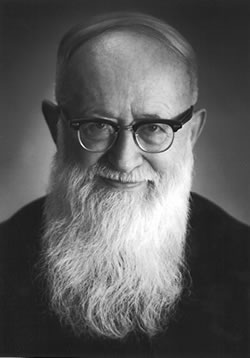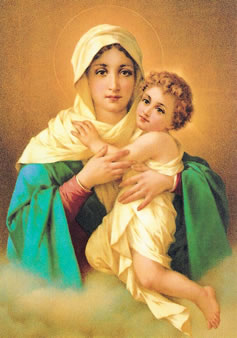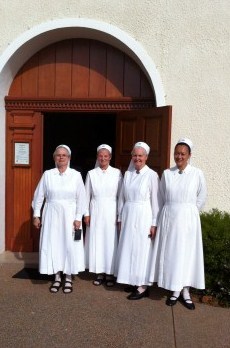The Shrine
A Place Of Pilgrimage
Schoenstatt is not so much a Movement with a Shrine; rather, it is a Shrine with a Movement. From the Shrine – the Original Shrine in the valley of Schoenstatt – everything was born and everything continues to be born, all its dimensions revolve around the Shrine. Everything that is Schoenstatt and has come since that Covenant of Love on October 14, 1914, which transformed an almost abandoned chapel into a place of grace is taken to the Shrine. The history of Schoenstatt is the history of the Shrine. In many movements, the history of that movement is the history of some initiative, of some idea, or of some act that took place. In our case, the history of Schoenstatt is born, developed, and ends with the history of the Shrine.
“You gather what I am aiming at: I would like to make this place a place of pilgrimage, a place of grace for our house and for the whole German province, and perhaps even further afield…..” This was the bold plan which Father Joseph Kentenich, Spiritual Director of the Minor Seminary of the Pallottine Fathers, proposed to his young students on that 18th of October of 1914, in the Schoenstatt Valley in Germany.
He was inviting them to work with the aim of transforming the old Chapel of St. Michael into a Marian Shrine (“this sanctuary which has stood more or less neglected, desolate and bare for as long as we can remember, has been – because of us and at our instigation – restored and given to the Mother of God.”) It had been two months since the great European war which would become the First World War had exploded.
Since that October day, more than nine decades have transpired. Father Kentenich died on September 15, 1968, but his words from that time have become a reality. The prophet was right. Or better still, the prophet detected God’s plan for that place. He discovered a source of grace – at that time there was a mere trickle of water – which today has become a powerful current of graces, of life and ideas reaching many countries and all continents.
The word Schoenstatt is pronounced in Paraguay, Australia, the USA, the Caribbean, South Africa, and India…
That little chapel dedicated to St. Michael the Archangel is actually the “original” Shrine which has multiplied itself in Germany, Europe and the world through a web of more than 200 “daughter” Shrines. It was officially recognized by the Church as a Shrine in 1947.
The Founding Moment the 18th of October 1914 in the original Shrine
If you want to understand something in depth, you should ask about its roots. If we want to grasp what Schoenstatt is, we have to investigate the founding act from which it has developed.
This takes us to a place – Schoenstatt – in the valley of Vallendar (Germany) and to a date, October 18, 1914. On that day in the old chapel of St. Michael which had been recently restored, Father Kentenich sealed a Covenant of Love with the Blessed Virgin. The talk he gave on that occasion to the young seminarians was acknowledged by him, many years later, as the founding document of the Schoenstatt Movement. His testimony is decisive.
Upon comparing the history of the Schoenstatt Shrine with other places where the Virgin Mary has also manifested herself, we confirm likenesses and differences. Something common to all: God always seeks human instruments through which he comes close to mankind. In October of 1914, the Mother of God takes a new initiative in Schoenstatt, Germany and now the human instrument is a young 29 year old priest, Father Joseph Kentenich. Up to here are the likenesses.
On that 18th of October, Father Kentenich tells his listeners of “a secret and favorite idea,” a “bold thought,” something he had been chewing on for quite some time. Would it then not be possible for our little sodality chapel to likewise become for us the Tabor on which the glory of Mary would be revealed? Three months earlier, on the 18th of July, he had received an article written by Father Cipriano Frolich telling the story of the Shrine of Pompei (Italy). It had come forth, not as in other places by an apparition of the Virgin Mary. God chose a human instrument there to fulfill his plans: a lawyer, Bartolo Longo (recently beatified by His Holiness John Paul II). The parallel was convincing.
What had taken place in Pompei, could it not also take place in Schoenstatt? His proposal was truly daring. But – he told the young seminarians – “How often in world history have not small and insignificant beginnings been the source of great and greater accomplishments! Why could that not also hold true in our case?”
The history of Schoenstatt since that day – a day like any other, but at the same time, a different day – proves that those desires became facts.
The little Schoenstatt Shrine has multiplied itself throughout the world through the “daughter” Shrines (the first was erected in Nueva Helvecia, Uruguay). The presence of Mary and the manifestation of her glories has multiplied through the numerous Home Shrines in the families. In all of these places, Mary wants to manifest herself as Mother and Educatrix, working great things. But in all she also demands, according to permanent laws of salvation history, human cooperation. It is thus expressed in the motto:
Schoenstatt, a place of pilgrimage.
Many people asked themselves if the Virgin had appeared as usually happens in other holy places, for example, Lourdes or Fatima. No, in Schoenstatt there was no apparition of the Mother of God. But she has certainly manifested herself from this small place. There, she has taken a divine initiative through a priestly instrument, Father Kentenich. “All those who come here to pray – he said in the talk on October 18, 1914 – shall experience the glory of Mary.” There, where the Virgin Mary makes herself present, there, life comes forth. There, where she is, we find peace.
There, where she has established herself, she gives her treasures in abundance, her graces. She always favors mankind, her children, and as all good mothers, she does it in such a way that she is especially concerned for those who suffer the most, those who are in greatest need, those who are the weakest. That is how a mother works, that is how Mary works.
Schoenstatt, a place of pilgrimage for today.
There are many and varied Marian Shrines throughout the world. Many are the graces which Mary dispenses from each place. Why would she have also wanted to manifest herself in Schoenstatt? To answer this question, what better than to turn to the witness of her main instrument, Father Kentenich and to the history which resulted from the foundation.
With a keen perception of the problems of his age and with a deep intuition of the future, Father Kentenich perceived that we were facing a radical change in the world. And, in the center of the problem, he saw mankind. He could see a growing massman process. He could perceive the danger of the uprooting of personal and traditional values. He could perceive the growing phenomenon of atheism which was already developing. He understood that the new times required a new type of person. The Virgin Mary should be his Mother and anew give birth to Christ in the hearts of mankind. In Schoenstatt and from Schoenstatt , she wanted to especially show herself as Educatrix of that “new man” and of that “new community.”
We should also question the history, question what occurred since that 18th of October of 1914. The facts speak an eloquent language. Thousands of persons have found a spiritual home in Schoenstatt. There, they have received special graces.
From that small chapel in the valley, a strong movement of spiritual renewal has come forth, a great religious current which increases and increases according to the measure in which it advances. It is seeking the “new shores” of the future. It is a movement which seeks the transformation of people into Christ through a Covenant of Love with Mary. It is a current of heroic surrender and sanctity (this was one of the demands of the original plan: “Accelerate the development of our own sanctification and in this way transform our Chapel into a place of pilgrimage.”) Six Secular Institutes have arisen, communities of Catholic leaders, contemplative communities, a vast lay movement, a movement of the people and of pilgrims.
Where the Virgin Mary is, there the Lord is present and there the Spirit is active. We will never be able to understand or to fully value the marvelous works of the Lord. Sufficient is it to perceive His nearness in order to experience a profound awe and to feel gratitude arising in us. That is how Father Kentenich expressed it prayerfully.
Thank you, Father, for choosing Schoenstatt as the place of God’s rebirth and the place where you radiate into the world the glories of our Mother, so that streams of love may pour forth to warm cold hearts.
– Fr. Esteban Uriburu

Father Kentenich
With Mary
Father Joseph Kentenich was born in Gymnich near Cologne, Germany on November 18, 1885. As a youth he recognized his calling to become a priest.
Nothing moved him more than his concern that the reality of God be recognized in the world and that the freedom and dignity of every person be respected.
In Mary, the Mother of God, he saw the example for each person’s relationship to God. In everything that he undertook he felt called to form this “new ” Marian person.
First he worked as a teacher and educator in the Pallottine House of Studies in Schoenstatt, Vallendar. An extraodinary bond of trust developed between him and his students. They made his love for Our Lady their own and learned to see Mary as a bridge to God.
October 18, 1914 became a milestone in Schoenstatt’s history. Alert to the signs of the time and listening keenly in order to perceive the special wishes of God, Father Kentenich—together with a small group of students—entered into a COVENANT OF LOVE WITH OUR LADY in the chapel at Schoenstatt. This was the beginning and the lasting foundation of today’s worldwide development of the Schoenstatt Movement.
For the People
After 1914 the circle of those who knew Father Kentenich expanded extensively. He became the founder of several communities for priests, families, men, women and youths.
SCHOENSTATT developed into a movement of religious and moral renewal, the chapel became a place of PILGRIMAGE, a SHRINE, where large numbers of pilgrims experience Mary as a mother and educator.
Here they receive the grace of a spiritual home, of inner transformation and apostolate.
Through life’s trials they learn to accept God’s way of education as an opportunity to sanctify everyday life and to assume responsibility for others.
Throughout his life, Father Kentenich received the special grace of sharing in the cross of Jesus Christ. During the time of persecution under National Socilism, he spent more than three years in prison and concentration camp.
From 1951-1965 he was separated from his work by decree of the Church. He considered this type of personal imitation of Christ as understood, and in the midst of all the trials, he himself became a FATHER for many. He saw everything, including the cross, as an expression of the merciful, fatherly love of God.
For the Church
Through his life and suffering Father Kentenich wanted to serve the Church he loved.
At the end of the Second Vatican Council he was received in audience by Pope Paul VI, who expressed recognition of his life and work. Again, Father Kentenich placed himself and the Schoenstatt Movement at the service of the Church.
On Sunday, September 15, 1968, feast of the Seven Sorrows of Our Lady, immediately after the holy sacrifice of the Mass, he placed his life into the hands of God forever. He died renowned for his sanctity.
The process for the beatification of Father Joseph Kentenich was opened on February 10, 1975. Each year, thousands come to his final resting place in the Church of the Trinity on Mount Schoenstatt. Confidently, they bring their concerns or their thanksgiving for help that they have received.

Mother Thrice Admirable
AN IMAGE OF GRACE
Schoenstatt is centred on the covenant of love with the Blessed Mother. This Marian emphasis is what most people know about Schoenstatt. As with the Schoenstatt image of grace, its Marian spirituality also emphasises Mary’s relationship with Jesus, their two-in-oneness. She is the great Christ bearer to mankind, the permanent companion and collaborator of Christ the Saviour in every salvific work.
The great grace that Mary in Schoenstatt is asked for is to become more like her. Mary is God’s incorruptible vision for mankind, the woman who is fully human but formed with Christ, a collaborator in the Father’s plan who invites us to build His kingdom freely and actively.
This is the picture of the Thrice Admirable Mother, Queen and Victress of Schoenstatt – a picture of grace. It is a print of the original painting done by the Italian artist Crosio towards the end of the nineteenth century. The original title of this picture was “Refugium Peccatorum” – “Refuge of Sinners”. It was put up in the shrine at Schoenstatt
in Germany in 1915.
In the picture we see Mary, the Mother of God, with her Child, Jesus. One is struck by the unity between Mother and Child. Mary holds her Child with both hands. Her left hand presses him to herself; her right hand holds his arm, and at the same time offers it upwards. Yet, however, much her attitude unites her with the Child, she holds him in a completely detached way. Is she waiting for someone to ask for her Child? Her eyes speak of this expectation.
Looking at the picture we find a deepened expression of the heartfelt unity between Mother and Child:
the tone of the colors becomes deeper towards the center and leads one’s eye to the Mother’s heart.
The Child rests there, whilst her hand rests at his heart. So it is that heart is united to heart.
Two hearts unite in one beat.
“The heart is the innermost center of the spiritual life of a person” (Pope Paul VI). The picture of the MotherThrice Admirable , Queen and Victress of Schoenstatt speaks of the fact that Mary’s soul is totally formed into Jesus: he determines her whole being. He is the content of her life. He is the one who possesses her heart, her love. Is it thus surprising that the features of the two are so strikingly similar?
So it is that when we contemplate this picture of grace we realize: Our Lady leads all who attach themselves to her, to her Child, to the center of his heart. And there we find the Father.

Sisters
SCHOENSTATT SISTERS OF MARY
A REMARKABLE STORY Sr. M PATROCLA STUEKER
It is our mission to bring the presence of Christ wherever we are, discovering God’s love in every person, in all creation and in every event of our lives.
To Follow Christ…
We are called to follow Christ by giving ourselves to him through a Covenant of Love with Mary. Mary is our mother, sister, model and educator. She inspires us to deepen our love for Christ and to form a genuine family-like community with a spirituality which is deeply rooted in the Covenant of Love with her.
To Serve Christ…
We are involved in a variety of professions and ministries to proclaim the Gospel, including:
• Pastoral care
• Health care
• Overseas mission work
• Retreat and Spirituality centres
• Education
• Business
• Formation of girls, women and families within the Schoenstatt Movement.
To Love Christ…
Through a lifestyle which offers a balance of prayer, ministry and community we are committed to faithfulness to the Church and to our Community.
We foster a wholesome, harmonious view of life, working for equality and justice as we care for our members and those with whom we work.
By being flexible and adaptable we can bring Christ and Mary to every sphere.
Our lifestyle allows us to wear a uniform or lay dress, living in community settings or alone.
“All who give and consecrate themselves to our Blessed Mother may expect countless blessings from God.” -Fr. Joseph Kentenich
The Secular Institute of the Schoenstatt Sisters of Mary was founded by Fr Joseph Kentenich on the 1st October 1926 in Schoenstatt, Germany. The first members arrived in Australia in 1951. Our community is one of the first secular institutes in the Church.
Members of Secular Institutes work for the evangelization of our contemporary society. They seek ‘to express and insert the Gospel as salt and leaven into the reality of the world in which they live and work.’ (Blessed John Paul II)
Today more than 2500 sisters from 35 countries serve the Church across the globe.
For more information please contact:
Community Leader Schoenstatt Sisters of Mary
9 Talus Drive Mt Richon WA 6112
08 9399 2349
